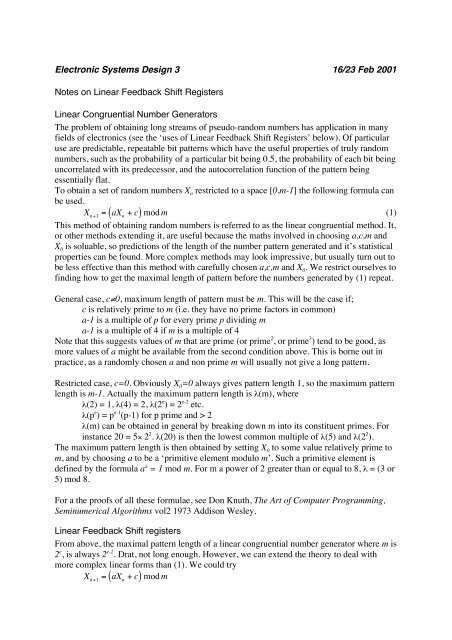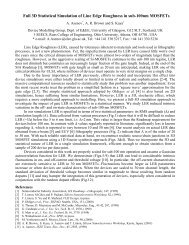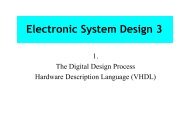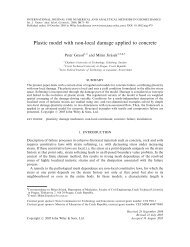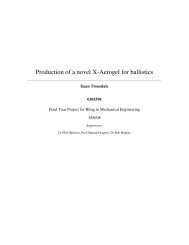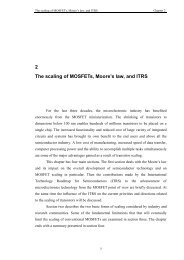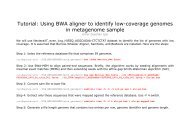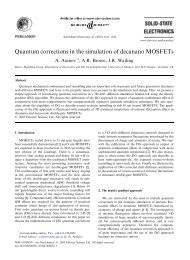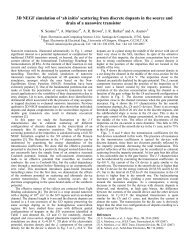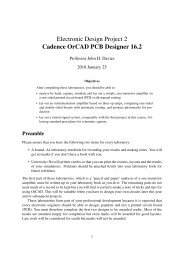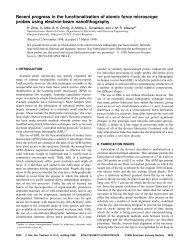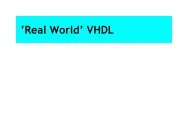Linear Feedback Shift Registers
Linear Feedback Shift Registers
Linear Feedback Shift Registers
- No tags were found...
Create successful ePaper yourself
Turn your PDF publications into a flip-book with our unique Google optimized e-Paper software.
Built-in self-test: Another test strategy you may want to employ is built-in self-test (BIST).Devices using BIST contain special test generators and result-gathering circuits, both ofwhich you can implement using LFSRs.Pseudorandom numbers: Many computer programs, including games, digital and analogsimulators, and graphic packages, rely on random sequences. You can generate pseudorandomsequences using LFSRs. In fact, pseudorandom numbers have an advantage overtruly random numbers, because many computer applications typically require repeatability.However, designers also need the ability to modify the seed value of the pseudorandomnumbergenerator, to create alternative pseudorandom sequences.Optimised ‘counters’. Use in FIFOs instead of binary counters. The position flags in a FIFOdo not need to actually count in binary, they just need to span the whole memory heirarchy.So build them from LFSR and then you have less logic in the critical logic paths and a fasterfinal design.Properties of <strong>Linear</strong> <strong>Feedback</strong> <strong>Shift</strong> <strong>Registers</strong>One full cycle has the number of ‘1’s one greater than the number of ‘0’sIn one full clock cycle the probability of having a ‘1’ follow another ‘1’ or ‘0’ follow another‘0’ is approximately half.In one full cycle a cyclical shift has the number of disagreements one greater than thenumber of agreements - the autocorrelation function has no side lobes and therefore no areamore likely to give false readings in noisy environments.‘Famous’ <strong>Linear</strong> <strong>Feedback</strong> <strong>Shift</strong> <strong>Registers</strong>Modem Checksum Protocols. CRC for the Comité Consultatif Internationale Télégraphique etTéléphonique (CCITT) has x 16 +x 12 +x 5 +1 for many standard modem protocols. x 16 +x 15 +x 2 +1used by IBM.Navstar Global Positioning System.The codes transmitted by the Navstar satellites aredeterministic binary sequences with noise-like properties. Two codes are transmitted: theC/A, or coarse/acquisition, code and the P, or precision, code. Both codes are generated usinglinear feedback shift registers (LFSRs).The C/A-code is generated by two 10-bit LFSRs. One of these is a 1 + x 3 + x^10 registerreferred to as G1. Theother, G2, has polynomial representation 1 + x^2 + x^3 + x^6 + x^8+ x^9+ x^10. In this case, the output comes not from cell 1 but from a second set of taps. Variouspairs of these second taps are binary added. The different pairs yield the same sequence butwith different delays or shifts (as given by the 'shift and add' or 'cycle and add' property ofLFSR sequences: a chip-by-chip sum of a LFSR sequence and any shift of itself is the samesequence except for some shift). The delayed version of the G2 sequence is binary added tothe output of G1. That becomes the C/A-code. The G1 and G2 shift registers are set to the allones state in synchronism with the epoch of the X1 code used in the generation of the P-code(see below). The various alternative pairs of G2 taps (delays) are used to generate thecomplete set of 36 unique PRN C/A-codes. This family of codes is a subset of codes knownas Gold codes which have the property that any two have a very low cross correlation (arenearly orthogonal).
There are actually 37 PRN C/A-codes, but two of them (34 and 37) are identical. The first 32codes are assigned to satellites. Codes 33 through 37 are reserved for other uses such as forground transmitters.The P-code generation follows the same principles as that for the C/A-code, except four, 12-cell shift registers are used. Two registers are combined to produce the X1 code, which is 15345 000 chips long and repeats every 1.5 seconds; and two registers are combined to producethe X2 code, which is 15 345 037 chips long. The X1 and X2 codes can be combined with 37different delays on the X2 code to produce 37 different one-week segments of the P-code.Each of the first 32 segments is associated with a different satellite. The remaining 5 arereserved for other uses in conjunction with the last 5 C/A-codes.Other checksumsInternational Book Standard Number ISBN10d 1 + 9d 2 + 8d 3 … = 0 (mod 11)Mastercard2^d 1 + d 2 + 2^d 3 … =0 (mod 10) where ^ is multiplication and digit add.These methods could not in all honesty be said to be particularly elegant.
VHDL for <strong>Shift</strong> Register (after Wakerly)LIBRARY ieee;USE ieee.std_logic_1164.all;entity shift_reg isport (CLK, RESET, RIN, LIN: in STD_LOGIC;S: in STD_LOGIC_VECTOR (2 downto 0);D: in STD_LOGIC_VECTOR (7 downto 0);Q: in STD_LOGIC_VECTOR (7 downto 0));end shift_reg;architecture behavior of shift_reg issignal IQ: STD_LOGIC_VECTOR (7 downto 0);beginprocess (CLK,RESET,IQ)beginif (RESET=’1’) then IQ null;when 1 => IQ IQ IQ IQ IQ IQ IQ null;end case;end if;Q
VHDL for simple ring counter (completely over the top)LIBRARY ieee;USE ieee.std_logic_1164.all;entity ring_counter isport (CLK, RESET: in STD_LOGIC;Q: in STD_LOGIC_VECTOR (3 downto 0));end ring_counter;architecture behavior of ring_counter istype state is (one,two,three,four);signal PRESENT_STATE, NEXT_STATE : state;begin-- process makes sure that the state machine ticks every clock cycle-- and that those ticks happen on the +ve edge. Generic stuffprocess(CLK,RESET)beginif RESET='1' thenPRESENT_STATE


